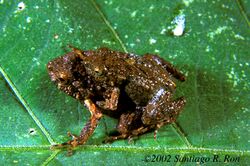Biology:Engystomops coloradorum
| Engystomops coloradorum | |
|---|---|

| |
| Scientific classification | |
| Domain: | Eukaryota |
| Kingdom: | Animalia |
| Phylum: | Chordata |
| Class: | Amphibia |
| Order: | Anura |
| Family: | Leptodactylidae |
| Genus: | Engystomops |
| Species: | E. coloradorum
|
| Binomial name | |
| Engystomops coloradorum | |
| Synonyms[3] | |
|
Physalaemus coloradorum Cannatella and Duellman, 1984[2] | |
Engystomops coloradorum, also known as Colorado dwarf frog, is a species of frogs in the family Leptodactylidae. It is endemic to the Pacific lowlands and foothills of the Andes in the Pichincha and Santo Domingo de los Tsáchilas Provinces, Ecuador.[1][3][4]
Description
Adult males measure 18–24 mm (0.71–0.94 in) and adult females 22–26 mm (0.87–1.02 in) in snout–vent length.[2][4] The snout is subacuminate. The tympanum is small, recessed, and smooth, whereas the tympanic annulus is granular. The forelimbs are slender; fingers are without webbing. The hind limbs are short and the toes have basal webbing. All dorsal surfaces have small tubercles, and there are large tubercles on head and body. The dorsum is brown and may have an orange-brown middorsal stripe posteriorly. The limbs are orange-brown; forelimbs have dark brown markings and hind limbs have dark brown to black bars. The venter is black and heavily mottled with white or bluish white, which becomes dark brown on flanks and hind limbs. The iris is pale grayish brown or dull bronze and has fine black reticulations.[2][4]
Habitat and conservation
Its natural habitats are tropical moist forests and more open, altered habitats at elevations of 100–1,100 m (330–3,610 ft) above sea level (AmphibiaWebEcuador puts the lower limit to 400 m[4]). It breeds in small, still waterbodies where it makes foam nests.[1][4] It can be locally abundant but its range is small.[4] Though adaptable, it is probably threatened by habitat loss.[1]
References
- ↑ 1.0 1.1 1.2 1.3 Luis A. Coloma, Santiago Ron, Diego Cisneros-Heredia, Ana Almendáriz (2010). "Engystomops coloradorum". IUCN Red List of Threatened Species 2010: e.T57247A11608582. doi:10.2305/IUCN.UK.2010-2.RLTS.T57247A11608582.en. https://www.iucnredlist.org/species/57247/11608582. Retrieved 15 November 2021.
- ↑ 2.0 2.1 2.2 Cannatella, David C.; Duellman, William E. (1984). "Leptodactylid frogs of the Physalaemus pustulosus group". Copeia 1984 (4): 902–921. doi:10.2307/1445335.
- ↑ 3.0 3.1 Frost, Darrel R. (2020). "Engystomops coloradorum (Cannatella and Duellman, 1984)". Amphibian Species of the World: An Online Reference. Version 6.1 (American Museum of Natural History). doi:10.5531/db.vz.0001. https://amphibiansoftheworld.amnh.org/Amphibia/Anura/Leptodactylidae/Leiuperinae/Engystomops/Engystomops-coloradorum. Retrieved 29 May 2020.
- ↑ 4.0 4.1 4.2 4.3 4.4 4.5 Read, M.; Ron, S. R. (2019). "Engystomops coloradorum". in Ron, S. R.; Merino-Viteri, A.; Ortiz, D. A.. Anfibios del Ecuador. Version 2019.0. Museo de Zoología, Pontificia Universidad Católica del Ecuador (QCAZ). https://bioweb.bio/faunaweb/amphibiaweb/FichaEspecie/Engystomops%20coloradorum.
Wikidata ☰ Q2238615 entry
 |


